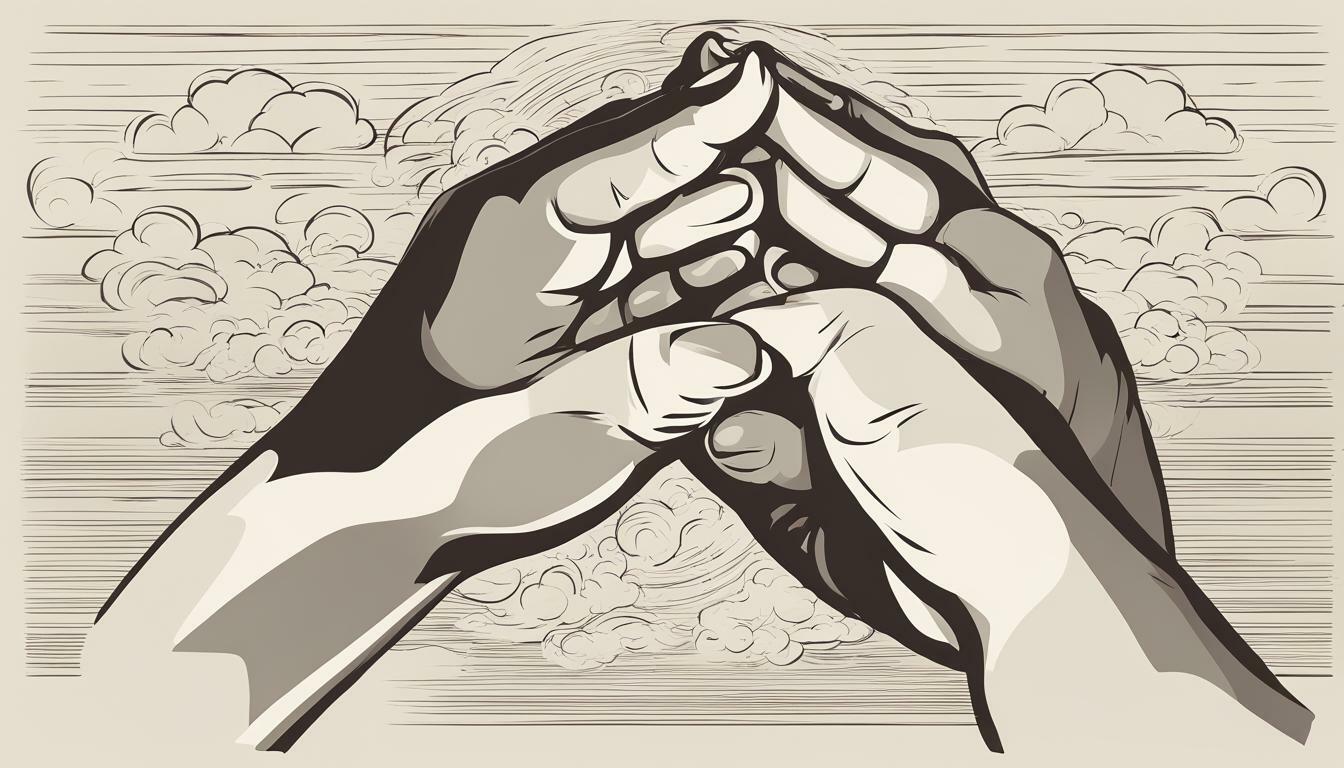Shaking hands is a common gesture of greeting and agreement in our society. But what does the Bible say about this practice? Is it merely a cultural custom or does it hold deeper significance? In this article, we will explore the biblical perspective on shaking hands and how it relates to our interactions with others.
Key Takeaways:
- The Bible mentions handshaking as a gesture of greeting and agreement.
- The act of shaking hands holds cultural and symbolic significance in the Bible.
- The importance of keeping agreements made through handshaking is emphasized in biblical teachings.
- Shaking hands can also be seen as a gesture of peace and reconciliation.
- Alternative forms of greeting and agreement-making, such as bowing or hugging, are mentioned in the Bible.
The Cultural Significance of Handshaking
In biblical times, shaking hands was an important gesture that conveyed a sense of greeting and agreement. This physical interaction was a way for individuals to show trust and respect for one another. The act of shaking hands had a deeply symbolic meaning, and it was considered to be a formal way of acknowledging someone.
Handshaking was used in scripture as a sign of agreement. For instance, in Genesis 31:55, Laban and Jacob shook hands to signify their agreement not to harm one another. Additionally, in 1 Kings 10:15, King Solomon made a treaty with the King of Tyre, and they ratified their agreement by shaking hands.
“Raise your hand if you are willing to give me your word!” So the man raised his hand, and David triumphantly led his troops out to battle. – 1 Chronicles 12:17 NLT
Overall, the act of shaking hands in the Bible conveyed a sense of respect, trustworthiness, and commitment. In today’s society, it is still seen as a polite and professional way to greet someone or seal an agreement.
Examples of Handshaking in the Bible
In many cultures, including the ancient Near East, handshaking served as a symbol of agreement, greeting, and mutual respect. The Bible mentions handshaking in several instances.
One notable example is found in Genesis 26:26-31, where Isaac and Abimelech make a covenant, or agreement. After negotiating terms for peace, “Isaac made a feast for them, and they ate and drank. Early the next morning the men swore an oath to each other. Then Isaac sent them on their way, and they went away peacefully. That day Isaac’s servants came and told him about the well they had dug. They said, ‘We’ve found water!'” (NIV). As a gesture of sealing their pact, Isaac and Abimelech exchanged a handshake.
Another example can be found in 2 Kings 10:15, where Jehu, a king of Israel, met with Jehonadab, the son of Rechab. After greeting each other, Jehu “took him up with him into the chariot” and brought him to a designated location. Their handshake signified not only a truce but also a shared commitment to an important cause.
“Now then, let’s make a covenant, you and I, and let it serve as a witness between us.” So Jacob took a stone and set it up as a pillar. He said to his relatives, ‘Gather some stones.’ So they took stones and piled them in a heap, and they ate there by the heap. Laban called it Jegar Sahadutha, and Jacob called it Galeed. Laban said, ‘This heap is a witness between you and me today.’ That is why it was called Galeed. It was also called Mizpah, because he said, ‘May the Lord keep watch between you and me when we are away from each other.'” -Genesis 31:44-49 (NIV)
Additionally, the Bible’s teachings consistently emphasize the importance of keeping one’s word and honoring agreements. Proverbs 6:20-22 exhorts, “My son, keep your father’s commandment, and do not forsake your mother’s teaching. Bind them always on your heart; tie them around your neck. When you walk, they will guide you; when you sleep, they will watch over you; when you awake, they will speak to you.” (NIV). When we make a promise or agreement with someone, we should take it seriously and uphold our end of the bargain.
The significance of handshaking in the Bible can be understood in the broader context of building relationships and fostering trust. Through this simple yet meaningful gesture, we can express our sincerity and goodwill towards others, paving the way for more harmonious and fruitful interactions.
The Importance of Honoring Agreements
In the Bible, the act of shaking hands was often used as a symbol of making an agreement or a vow. When two people shook hands, it was seen as a sign of their commitment to follow through on whatever they had agreed upon. Breaking an agreement made through handshaking was considered a serious offense that had negative consequences.
“When you make a vow to God, do not delay to fulfill it. He has no pleasure in fools; fulfill your vow. It is better not to make a vow than to make one and not fulfill it.” – Ecclesiastes 5:4-5
According to biblical teachings, making an agreement with someone and then breaking it shows a lack of integrity and respect for the other person. This can lead to a breakdown in trust, damaging relationships and leading to conflicts. The Bible stresses the importance of honoring agreements made through handshaking and fulfilling one’s commitments.
“Better a poor man whose walk is blameless than a fool whose lips are perverse.” – Proverbs 19:1
In addition, the Bible teaches that those who keep their promises and honor their agreements will be blessed with favor and prosperity.
“The Lord will grant you abundant prosperity – in the fruit of your womb, the young of your livestock and the crops of your ground – in the land he swore to your ancestors to give you. The Lord will open the heavens, the storehouse of his bounty, to send rain on your land in season and to bless all the work of your hands. You will lend to many nations but will borrow from none.” – Deuteronomy 28:11-12
Therefore, it is essential to understand the significance of handshaking and the importance of keeping one’s promises to maintain healthy relationships and lead a fulfilling life according to biblical teachings.
Shaking Hands as a Gesture of Peace
Throughout the Bible, we see examples of shaking hands as a gesture of peace and reconciliation. In fact, the act of shaking hands can have significant spiritual implications.
When we extend our hand to someone in greeting, we are offering a symbol of peace and goodwill. This is demonstrated in the book of Job, where Job declares, “If I have raised my hand against the fatherless, knowing that I had influence in court, then let my arm fall from the shoulder, let it be broken off at the joint” (Job 31:21-22).
The act of shaking hands can have significant spiritual implications.
Similarly, in the New Testament, we see Jesus use touch as a means of healing and reconciliation. In Mark 1:40-41, Jesus reaches out and touches a man with leprosy, saying, “I am willing. Be clean!” Through this simple act of touch, Jesus not only healed the man physically, but also restored him to his community.
Shaking hands can also be seen as an act of forgiveness. In the book of Genesis, we read about the story of Jacob and Esau, who had been estranged for years. When the two brothers finally reunite, they embrace and kiss each other, symbolizing their forgiveness and reconciliation (Genesis 33:4).
In all these instances, shaking hands is a physical representation of the inner work of forgiveness and reconciliation that takes place in our hearts. It is a reminder of the importance of extending peace and forgiveness to those around us.
The Symbolism of Touch in the Bible
In biblical times, touch had significant symbolism and carried both positive and negative connotations. For instance, touch was often associated with healing and restoration, such as when Jesus healed the blind and the lame by laying his hands on them (Matthew 9:27-30, Mark 1:40-42).
On the other hand, touch could also convey impurity and defilement, as in the case of lepers who were considered unclean and avoided by others (Leviticus 13:45-46).
“But Jesus reached out his hand and touched the man. ‘I am willing,’ he said. ‘Be clean!’ Immediately he was cleansed of his leprosy.” – Matthew 8:3 (NIV)
Handshaking, therefore, can be seen as a way to bridge the gap between people and promote mutual respect and reconciliation. By extending a hand, we acknowledge the other person’s presence and demonstrate a willingness to connect with them on a personal level. This is why handshaking is often used as a gesture of greeting, agreement, and goodwill.
The Bible also contains examples of touch being used in a negative sense, such as when Job’s friends accused him of sin and refused to touch him because they thought he was unclean (Job 19:17). Similarly, King Jeroboam’s hand withered after he stretched it out against a prophet who had spoken against him (1 Kings 13:1-6).
However, these negative examples do not negate the positive symbolism of touch in the Bible. Instead, they serve as a reminder of the importance of using touch in a respectful and appropriate manner, and of the potential consequences when it is misused.
The Power of Touch in the Bible
One of the most powerful examples of touch in the Bible is the story of the woman who touched Jesus’ robe in the hope of being healed of her bleeding disorder (Matthew 9:20-22). Despite the crowd pressing in around him, Jesus felt her touch and immediately knew that power had gone out from him. He turned to the woman and told her that her faith had healed her.
This story demonstrates the profound effect that touch can have on both the giver and the receiver. It also emphasizes the importance of faith and belief in the healing power of touch, which can bring about physical and emotional restoration.
Overall, the symbolism of touch in the Bible is complex and multifaceted. While it can convey both positive and negative connotations, it is ultimately a powerful tool for promoting connection, healing, and reconciliation. Handshaking, as one form of touch, can play an important role in our interactions with others and serve as a reminder of the biblical principles of respect, forgiveness, and integrity.
Modern Interpretation and Application
Although handshaking was prevalent in biblical times, modern society has alternative forms of greeting and agreement-making that do not involve physical touch. However, the biblical perspective on shaking hands is still relevant today in terms of integrity and trustworthiness in our interactions.
When we shake hands, we are making a verbal and nonverbal agreement with the other person. From a biblical perspective, this is a serious matter, as integrity and trustworthiness are highly valued virtues. Proverbs 10:9 says, “Whoever walks in integrity walks securely, but whoever takes crooked paths will be found out.”
Similarly, Jesus emphasizes the importance of honesty and straightforwardness in our interactions with others. In Matthew 5:37, He says, “Let your ‘Yes’ be ‘Yes,’ and your ‘No,’ ‘No.’ For whatever is more than these is from the evil one.”
Therefore, it is essential to honor our agreements made through handshaking, as breaking them can damage our reputation and relationships. The Bible teaches that when we make a vow or agreement, we should do everything in our power to fulfill it. Ecclesiastes 5:4-5 warns, “When you make a vow to God, do not delay in fulfilling it. He has no pleasure in fools; fulfill your vow. It is better not to make a vow than to make one and not fulfill it.”
Furthermore, shaking hands can also be seen as a gesture of peace and reconciliation, as it symbolizes the coming together of two parties. In Matthew 5:23-24, Jesus instructs his followers to reconcile with their brothers and sisters before offering their gifts to God.
While physical touch is not always necessary in our modern society, the biblical teachings on shaking hands can still be applied to our interactions with others. By being honest, trustworthy, and committed to our agreements, we can build strong and meaningful relationships based on mutual respect and understanding.
Alternatives to Handshaking in the Bible
While shaking hands is a common cultural practice today, there are alternative forms of greeting and agreement-making mentioned in the Bible.
- Bowing: In Genesis 33:3, Jacob bows seven times before his brother Esau, showing respect and submission. Similarly, in 1 Kings 1:16, Bathsheba bows before King David. Bowing can be seen as a symbol of reverence and humility.
- Hugging: In Genesis 33:4, Esau runs to embrace Jacob and kisses him. In Luke 15:20, the father runs to embrace his prodigal son. Hugging can be seen as a symbol of love and forgiveness, and as a way to show affection and closeness.
- Kissing: In 1 Samuel 10:1, Samuel anoints Saul as king and kisses him. In Luke 7:45, a woman anoints Jesus’ feet and kisses them. Kissing can be seen as a sign of respect and honor, as well as a symbol of love and devotion.
It is important to note that these alternative forms of greeting and agreement-making are not necessarily meant to replace handshaking, but rather to offer additional options depending on cultural context and personal preference.
Ultimately, the biblical guidance on shaking hands emphasizes the importance of integrity and trustworthiness in our interactions, regardless of the specific gesture used for greeting and agreement-making.
Conclusion
Shaking hands has been a significant gesture throughout history and continues to be an important aspect of our social interactions today. Understanding the biblical perspective on shaking hands can provide valuable insights into the cultural significance of this gesture.
As we have seen, the Bible mentions several instances of handshaking, and it was often used as a symbol of greeting and agreement. The importance of honoring agreements made through handshaking is also emphasized in the Bible, and breaking such agreements can have serious consequences.
Furthermore, shaking hands can also be seen as a gesture of peace and reconciliation in the Bible, and it is closely related to forgiveness and harmony. However, it is important to recognize that touch, including shaking hands, can have both positive and negative connotations in the Bible, depending on the context.
Applying the biblical teachings on handshaking to modern-day situations can help us maintain integrity and trustworthiness in our everyday interactions. In addition, the Bible provides alternatives to handshaking as a form of greeting and agreement-making, such as bowing or hugging, which can also have significant cultural and symbolic significance.
In conclusion, understanding the biblical perspective on shaking hands can shed light on the cultural and symbolic significance of this gesture. By incorporating these teachings into our interactions, we can strive for greater harmony and integrity in our relationships.




